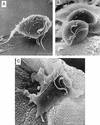Clinical and microbiological aspects of Trichomonas vaginalis
- PMID: 9564565
- PMCID: PMC106834
- DOI: 10.1128/CMR.11.2.300
Clinical and microbiological aspects of Trichomonas vaginalis
Abstract
Trichomonas vaginalis, a parasitic protozoan, is the etiologic agent of trichomoniasis, a sexually transmitted disease (STD) of worldwide importance. Trichomoniasis is the most common nonviral STD, and it is associated with many perinatal complications, male and female genitourinary tract infections, and an increased incidence of HIV transmission. Diagnosis is difficult, since the symptoms of trichomoniasis mimic those of other STDs and detection methods lack precision. Although current treatment protocols involving nitroimidazoles are curative, metronidazole resistance is on the rise, outlining the need for research into alternative antibiotics. Vaccine development has been limited by a lack of understanding of the role of the host immune response to T. vaginalis infection. The lack of a good animal model has made it difficult to conduct standardized studies in drug and vaccine development and pathogenesis. Current work on pathogenesis has focused on the host-parasite relationship, in particular the initial events required to establish infection. These studies have illustrated that the pathogenesis of T. vaginalis is indeed very complex and involves adhesion, hemolysis, and soluble factors such as cysteine proteinases and cell-detaching factor. T. vaginalis interaction with the members of the resident vaginal flora, an advanced immune evasion strategy, and certain stress responses enable the organism to survive in its changing environment. Clearly, further research and collaboration will help elucidate these pathogenic mechanisms, and with better knowledge will come improved disease control.
Figures

Similar articles
-
Biological roles of cysteine proteinases in the pathogenesis of Trichomonas vaginalis.Parasite. 2014;21:54. doi: 10.1051/parasite/2014054. Epub 2014 Oct 28. Parasite. 2014. PMID: 25348828 Free PMC article. Review.
-
Trichomoniasis: evaluation to execution.Eur J Obstet Gynecol Reprod Biol. 2011 Jul;157(1):3-9. doi: 10.1016/j.ejogrb.2011.02.024. Epub 2011 Mar 25. Eur J Obstet Gynecol Reprod Biol. 2011. PMID: 21440359 Free PMC article. Review.
-
The vagina of women infected with Trichomonas vaginalis has numerous proteinases and antibody to trichomonad proteinases.Genitourin Med. 1991 Dec;67(6):469-74. doi: 10.1136/sti.67.6.469. Genitourin Med. 1991. PMID: 1774051 Free PMC article.
-
Preliminary studies on target antigens for the diagnosis of Trichomonas vaginalis infection.J Microbiol Immunol Infect. 1999 Mar;32(1):14-20. J Microbiol Immunol Infect. 1999. PMID: 11561565
-
Trichomonas vaginalis and Mycoplasma hominis: new tales of two old friends.Parasitology. 2019 Aug;146(9):1150-1155. doi: 10.1017/S0031182018002135. Epub 2019 Jan 8. Parasitology. 2019. PMID: 30616707 Review.
Cited by
-
Structural elucidation of recombinant Trichomonas vaginalis 20S proteasome bound to covalent inhibitors.Nat Commun. 2024 Oct 4;15(1):8621. doi: 10.1038/s41467-024-53022-w. Nat Commun. 2024. PMID: 39366995 Free PMC article.
-
Microbial Matryoshka: Addressing the Relationship between Pathogenic Flagellated Protozoans and Their RNA Viral Endosymbionts (Family Totiviridae).Vet Sci. 2024 Jul 17;11(7):321. doi: 10.3390/vetsci11070321. Vet Sci. 2024. PMID: 39058005 Free PMC article. Review.
-
Uncovering the diversity of pathogenic invaders: insights into protozoa, fungi, and worm infections.Front Microbiol. 2024 Mar 25;15:1374438. doi: 10.3389/fmicb.2024.1374438. eCollection 2024. Front Microbiol. 2024. PMID: 38596382 Free PMC article. Review.
-
Impact of COVID-19 Pandemic on the Trends of Trichomonas vaginalis Infection in a Tertiary Hospital of Madrid, Spain.Microorganisms. 2024 Mar 20;12(3):620. doi: 10.3390/microorganisms12030620. Microorganisms. 2024. PMID: 38543671 Free PMC article.
-
The Past, Present, and Future in the Diagnosis of a Neglected Sexually Transmitted Infection: Trichomoniasis.Pathogens. 2024 Jan 29;13(2):126. doi: 10.3390/pathogens13020126. Pathogens. 2024. PMID: 38392864 Free PMC article. Review.
References
-
- Abonyi A. In vivo observations of the division of the oversized round forms of Trichomonas vaginalis in culture. Angew Parasitol. 1992;33:65–68. . (In German.) - PubMed
-
- Abonyi A. Examination of nonflagellate and flagellate round forms of Trichomonas vaginalis by transmission electron microscopy. Appl Parasitol. 1995;36:303–310. - PubMed
-
- Ackers J P. Immunologic aspects of human trichomoniasis. In: Honigberg B M, editor. Trichomonads parasitic in humans. New York, N.Y: Springer-Verlag; 1990. pp. 36–52.
Publication types
MeSH terms
LinkOut - more resources
Full Text Sources
Other Literature Sources
Medical
Research Materials

